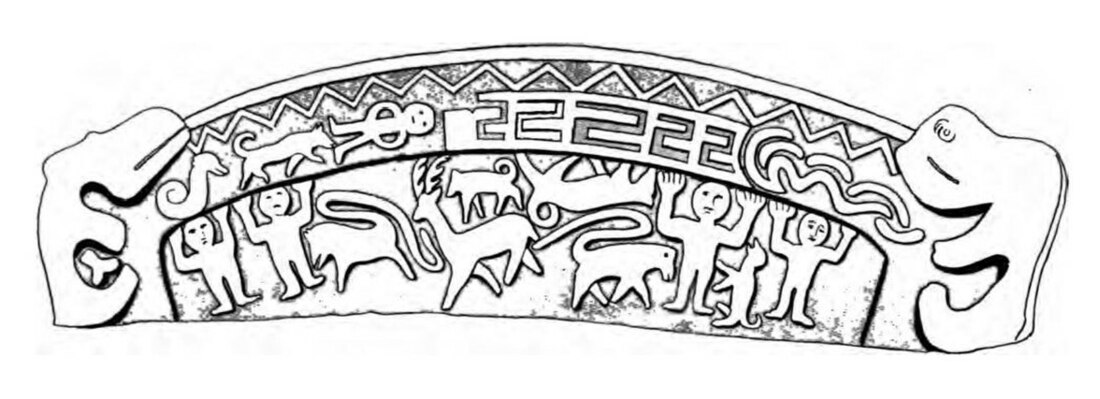Top Qs
Timeline
Chat
Perspective
Austri, Vestri, Norðri and Suðri
Four dwarfs who hold up the sky in Nordic mythology From Wikipedia, the free encyclopedia
Remove ads
In Nordic mythology, Austri, Vestri, Norðri and Suðri (Old Norse pronunciation: [ˈɔustre, ˈwestre, ˈnorðre, ˈsuðre])[citation needed]; are four dwarfs who hold up the sky after it was made by the gods from the skull of the jötunn Ymir. They are referred to both in Gylfaginning in the Prose Edda and in kennings. They have been further linked to dvergar ("dwarfs"), supports for the main beam of some halls, that are likely named due to the roof being seen as a reflection of the sky in Old Nordic religion.

Remove ads
Names and etymology
Austri, Vestri, Norðri and Suðri have been variously translated as "The one in the East, West, North and South" and "East, West, North and South".[2][3] The names derive from Old Norse: austr, vestr, suðr and norðr, meaning east, west, south and north respectively.[4]
Attestations
Summarize
Perspective
Gylfaginning
The longest description of the dwarfs is given in Gylfaginning from the Prose Edda, when after the death of Ymir, Odin (in his guise as Þriði) describes the creation of the sky:
Kennings
In the skald Hallfreðr vandræðaskáld's Óláfsdrápa Tryggvasonar, the kenning níðbyrðra Norðra ("Burden of the relations of Norðris") is used to refer to the sky.[6] In Skáldskaparmál, Snorri Sturluson says that one can refer to the sky or the heaven with kennings such as Old Norse: erfiði eða byrði dverganna ("Toil or burden of the dwarfs") and hjálm Vestra ok Austra, Suðra, Norðra ("Helm of Vestri and Austri, Suðri, Norðri").[7][8] An example of this is quoted from the work of Arnórr jarlaskáld.[7][note 1]
Völuspá
The four dwarfs are listed in the section of Völuspá, Dvergatal.[9]
Remove ads
Archaeological record
Heysham hogback
Scholars have proposed that Austri, Vestri, Norðri and Suðri are depicted holding up the sky on a hogback stone in Heysham in Lancashire, although this interpretation remains debated.[6][1] Although it has been argued that the dwarfs are depicted out of proportion and in a bestial manner, it has been noted that they closely resemble the human on the other side of the stone and it was unlikely that the carver intended to depict them as looking differently to humans.[10] It has been suggested that the role of the dwarfs in holding up the heavens would imply they were thought to be very tall; however, it has been noted that the sky could have been conceived of as being close to the earth at the horizon. Judgements on their size cannot be supported either way by the hogback stone as the size of the hogback stone imposed physical limitations on the size of depictions.[11]
Interpretation and discussion
Summarize
Perspective
Connection with hall "dwarfs"
It has been noted that the beams that support the roof of the house are known as dvergar ("dwarfs") in Old Norse. This has been connected by some scholars to Austri, Vestri, Norðri and Suðri, suggesting that, as in other cases, the home acts like a microcosm, in which the roof is equated with the sky.[6]
It has been noted that the small wooden blocks that held up the main beam of the roof (Old Norse: ás) were known as dvergar ("dwarfs"). This is first recorded in the 12th century Íslensk hómilíubók but likely reflects earlier naming practices, and is also seen in Denmark and Norway in later times.[12] The term is widely believed by scholars to originate in the traditions of Austri, Vestri, Norðri and Suðri, whose roles parallel the holding up of the main roof beam.[6][13] This supports the idea that North Germanic heathens saw the hall as representative of the wider world, with the roof equating to the heavens. It is further to be noted that the term for the main roof beam is the same in its singular form as ás, a member of the Æsir (though they differ in plural form).[14][note 2]
It has been argued that this mirroring of the world by the hall is further built up by the design of the hall and the imagery contained within it, such as in the use of pillars that reflect the central tree Yggdrasil. This phenomenon has been seen more widely in other cultural spaces, such as Christian churches, Navajo hogans and Cree tents.[15]
Remove ads
Notes
See also
- Anemoi, wind gods in Greek mythology assigned to the cardinal directions
- Atlas, a titan who holds up the sky in Greek mythology
- Four Heavenly Kings, beings in Buddhist tradition that watch over the cardinal directions
- Four Holy Beasts, beings in Chinese tradition assigned to the cardinal directions
- Royal stars, guardians of the corners of the sky in Persian tradition
References
Bibliography
Wikiwand - on
Seamless Wikipedia browsing. On steroids.
Remove ads
